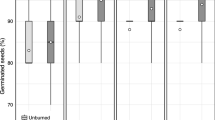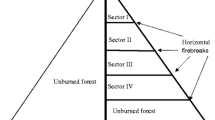Abstract
Fire modifies the germination of seeds of numerous species. One of the fire factors that cause these modifications is the ash. This study analysed the germination of seeds of Pinus sylvestris L., Pinus nigra Arn. Pinus radiata D. Don and Pinus pinaster Aiton, subjected to different ash treatments, and the development of seedlings that grew in these conditions for 14 weeks. We obtained the ash by completely burning leaves and small twigs from the most abundant woody species in populations of pines. The ash treatments applied were as follows: Control (without ash), Low (half of the amount registered in a fire), Medium (equal to the amount registered in a fire) and High (double the amount registered in a fire). Germination took place on paper inside Petri dishes and in soil, and growth was only analysed for the plants that grew in the soil. For all species, and especially P. nigra, germination rate decreased as the amount of ash applied increased. The negative effects of the ash were more apparent following treatments in Petri dishes than in the soil. In the dishes, the average germination time varies little between the four species of pine. In soil, the average germination time is more prolonged, and only some differences were observed between treatments in P. sylvestris and P. nigra. In these species the high treatment significantly increased the average germination time. We found a greater sensitivity of P. sylvestris and P. nigra to the addition of ash, showing a higher seedling mortality rate. However, it appears that seedling development (length and weight) was not affected in any of the species through the addition of ash. These tests allow us to deduce that, in P. sylvestris, P. nigra, P. radiata and P. pinaster, the ash produced by forest fires has an inhibiting effect on germination and little effect on the development of seedlings in the first months of life.
Similar content being viewed by others
References
Agee J.K. 1998. Fire and pine ecosystems. In: Richarrdson D.M. _ed._, Ecology and Biogeography of Pinus. Cambridge University Press, Cambridge, UK. pp. 193–218.
Carreira J.A., Niell F.X. 1995. Mobilization of nutrients by fire in a semiarid gorse-shrubland ecosystem of Southern Spain. Arid soil Research and Rehabilitation 9: 73–89.
Côme D. 1970. Les obstacles à la germination. Masson, Paris, France.
Elena-Rosselló R., Sánchez-Palomares O. 1991. Los pinares españoles de Pinus nigra Arn.: Sintesis ecológica. Ministerio de Agricultura, Madrid, Spain.
Escudero A., Barrero S., Pita J.M. 1997. Effects of high temperatures and ash on seed germination of two Iberian pines _Pinus nigra ssp salzmannii, P. sylvestris var iberica_. Annales des Sciences Forestieres 54: 553–562.
Gandullo J.M., González-Alonso S., Sanchez-Palomares O. 1974. Ecología de los pinares españoles. IV Pinus radiata D. Don. Ministerio de Agriculrura, Madrid, Spain.
González-Rabanal F. and Casal M. 1995. Effect of high temperatures and ash on germination of ten species from gorse shrubland. Vegetatio 116: 123–131.
González-Rabanal F., Casal M., Trabaud L. 1994. Effect of high temperatures, ash and seed position in the inflorescence on the germination of three Spanish grasses. Journal of Vegetation Science 5: 289–294.
Keeley J.E. 1992. Recruitment of seedlings and vegetative sprouts in unburned chaparral. Ecology 73: 1194–1208.
Keeley J.E., Zedler P.H. 1978. Reproduction of chaparral shrubs after fire: a comparison of sprouting and seedling strategies. The American Midland Naturalist 99(1): 142–161.
Keeley J.E., Zedler P.H. 1998. Evolution of life histories in Pinus.. In: Richardson D.M. (ed.), Ecology and Biogeography of Pinus. Cambridge University Press, Cambridge, UK. pp. 219–250.
Kruger F.J. 1977. Ecology of Cape fynbos in relation to fire.. In: Mooney H.A. and Conrad C.E. _eds_, Proceedings of the Symposium on the Enviromental Consequences of Fire and Fuel Management in Mediterranean Ecosystems, pp. 230-244. USDA For. Serv. Tech. Rep. WO-3.
Kutiel P. and Kutiel H. 1989. Effects of a wildfire on soil nutrients and vegetation in aleppo pine on Mount Carmel, Israel. Pirineos 134: 59–74.
Martínez-Sánchez J.J., Marín A., Herranz J.M., Ferrandis P. and De las Heras J. 1995. Effects of high temperatures on germination of Pinus halepensis Mill. and P. pinaster Aiton subsp. pin-aster seeds in southeast Spain. Vegetatio 116: 69–72.
Naveh Z. 1974. Effects of fire in the Mediterranean region.. In: Kozlowski T.T. and Ahlgren C.E. _eds_, Fire and Ecosystems. Academic Press, New York, New York, USA, pp. 401–434.
Naveh Z. 1975. The evolutionary significance of fire in the Mediterranean region. Vegetatio 43: 5–21.
Neéman G., Lavah H., Izhaki I. 1992. Spatial pattern of seedlings one year after fire in a Mediterranean pine forest. Oecologia 91: 365–370.
Neéman G., Meir I., Neéman R. 1993. The effect of ash on the germination and early growth of shoots and roots of Pinus, Cis-tus and annuals. Seed Science and Technology 21: 339–349.
Nicolás A., Gandullo J.M. 1969. Ecología de los pinares españoles. II Pinus sylvestris L. Ministerio de Agricultura, Madrid, Spain.
Purdie R.W. and Slatyer R.O. 1976. Vegetation succession after fire in sclerophyll woodland communities in South-Eastern Australia. Australian Journal of Ecology 1: 223–236.
Raison R.J. 1979. Modification of the soil environment by vegetation fires, with particular reference to nitrogen transformations: a review. Plant and Soil 51: 73–108.
Reyes O. 1996. Estrategias regenerativas de especies arbóreas de ecosistemas forestales de Galicia en relación con incendios: análisis del comportamiento germinativo y de la demografía de plántulas. Tesis Doctoral Universidad de Santiago de Compostela, Spain.
Reyes O. and Casal M. 1995. Germination behaviour of 3 species of the genus Pinus in relation to high temperatures suffered during forest fires. Annales des Sciences Forestières 52: 385–392.
Reyes O. and Casal M. 1998a. Germination of Pinus pinaster, P. radiata and Eucalyptus globulus in relation to the amount of ash produced in forest fires. Annales des Sciences Forestières 55: 837–845.
Reyes O. and Casal M. 1998b. Are the dominant species in N.W. Spain fire-prone?. In: Trabaud L. (ed.), Fire Management and Landscape Ecology, pp. 177-188. International Association of Wildland Fire, Washington, USA.
Reyes O., Casal M., Trabaud L. 1997. The influence of population, fire and time of dissemination on the germination of Betula pen-dula seeds. Plant Ecology 133: 201–208.
Richardson D.M., Rundel P.W. 1998. Ecology and Biogeography of Pinus: an introduction.. In: Richarrdson D.M. (ed.), Ecology and Biogeography of Pinus. Cambridge University Press, Cambridge, UK, pp. 3–46.
Shiller G., Waisel Y. 1989. Among-provance variation in Pinus halepensis in Israel. Forest Ecology and Management 28: 141–151.
Soto B., Basanta R., Diaz-Fierros F. 1997. Effects of burning on nutrient balance in an area of gorse _Ulex europaeus L._ scrub. The Science of Total Environment 204: 271–281.
Thanos C.A., Skordilis A. 1987. The effects of light, temperature and osmotic stress on the germination of Pinus halepensis and P. brutia seeds. Seed Science and Technology 15: 163–174.
Trabaud L. 1970. Quelques valeurs et observations sur la phytodi-namique des surfaces incendiées dans le Bas-Languedoc. _Premiers résultats_. Naturalia Monspeliensis Ser. Bot. Fasc. 21: 231–242.
Trabaud L. 1980. Impact biologique et écologique des feux de végétation des zones de garrigues du Bas-Languedoc. Thèse es Sciences. Université des Sciences et Technique du Languedoc, Montpellier, France.
Trabaud L. 1984. Fire adaptation strategies of plants in the French Mediterranean region. In: Margaris N.S., Arianoutsou-Faraggi-taki M. and Oechel W.C. _eds_, Being alive in land. Dr W Junk Publishers, The Hague, The Netherlands. pp. 63–69.
Trabaud L. 1987. Fire and survival traits of plants.. In: Trabaud L. ed._, The Role of Fire in Ecological Systems. SPB Academic Publishing, The Hague, The Netherlands, pp. 65–89.
Trabaud L. 1988. Survie des jeunes plantules de pin d´alep apparues après incendie. Studia Ecologica 5: 161–170.
Trabaud L. and Casal M. 1989. Résponses des semences de Ros-marinus offýcinalis à diferents traitments simulant une action de feu. Acta Oecol-Oecol Appl 10: 355–366.
Van Wilgen B.W. and Siegfried W.R. 1986. Seed dispersal properties of three pine species as a determinant of invasive potential. South African Journal of Botany 56: 546–548.
Author information
Authors and Affiliations
Rights and permissions
About this article
Cite this article
Reyes, O., Casal, M. Effects of forest fire ash on germination and early growth of four pinus species. Plant Ecology 175, 81–89 (2004). https://doi.org/10.1023/B:VEGE.0000048089.25497.0c
Issue Date:
DOI: https://doi.org/10.1023/B:VEGE.0000048089.25497.0c




